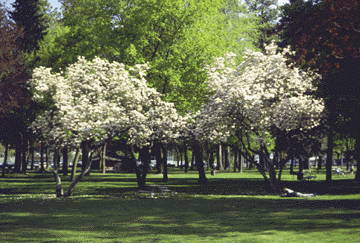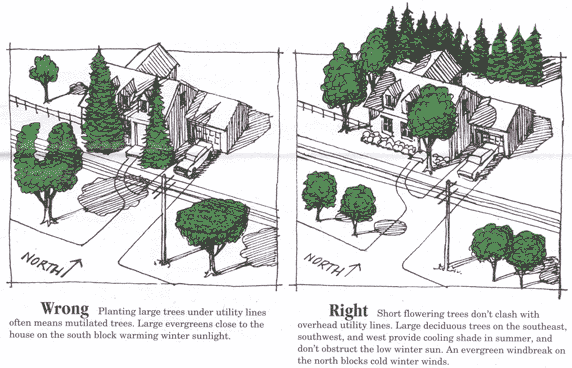Tree Selection
Selecting the Right Tree for the Right Place
Tree selection is far too often a spontaneous decision. Prior to selection, more time should be spent in considering a number of factors including:
- What you want the tree to do
- The characteristics of the planting site
- Pest and hardiness factors
- Species characteristics
Most trees are planted to make our lives more agreeable and pleasant by increasing our physical or material comfort. A tree that is large at maturity will provide shade. An ornamental tree has beautiful flowers, leaves or bark. A tree that has dense, persistent leaves will provide a windbreak, a screen or privacy. A tree that drops its leaves in the fall will allow the sun to warm houses in the winter. A tree that produces fruit will attract birds and wildlife.
Planting Site
Trees are living organisms that grow larger each year increasing in height, in crown width and in size of root system. Consider the amount of room available. Overhead utility lines will restrict selection to small trees. Trees with low, spreading branches are appropriate for screens but not for along streets where visibility is essential. Consider also, the amount of available sunlight, the amount and source of water available, and potential competition with other plants and/or trees. Soil that is well-drained and contains the mineral elements, air, water, and organic matter required for adequate growth can make all the difference in the overall health of the tree. Soil texture and water holding capacity are important. Available nutrients, soil pH and organic matter content factor into good plant growth. Soil pH (acidic, alkaline) affects nutrient availability. A pH of 5.5 to 6.5 is optimum for most trees and shrubs.
Some tree species tolerate "challenging" conditions better than others. Knowing your planting site will help you in tree selection.
Pest and Hardiness Factors
Insect pests and disease organisms affect almost every tree and shrub species. However, some species are more susceptible than others. These problems can be overcome with increased care. Consider how "care free" you want you trees to be. Plants are suitable to a specific, or a range of temperature hardiness zones. Coeur d’Alene is in zone 5 based upon USDA Plant Hardiness zone maps. Look for species hardy to that zone number or lower.
Selecting the Species
Once the characteristics of the site are determined and evaluated, then it’s time to pick out a tree. Personal preferences are especially important at this stage. Aesthetics and function should be integrated into the selection process. Tree form or shape, mature height, growth rate, longevity, and ornamental features of foliage, bark, flower and fruit including color, texture, season, and size and fall coloration are important considerations.
The City or Coeur d’Alene’s Urban Forestry program has developed an Approved Street Tree List. This list is arranged by mature size: small, medium, large.
To view some of these recommended trees, visit the G.O. Phippeny Park on 7th and Montana. A variety of trees are planted at this park to help citizens become familiar with trees suitable for planting along streets. A tree permit is required to plant a tree within the right-of-way in the city limits of Coeur d’Alene. There are many trees not on the Approved Street Tree list available at local nurseries. If your space is not in the right-of-way or along the street, consider planting something different or unique. We encourage tree diversity! There’s a tree perfectly suited for your space and your needs; don’t settle for less.








